This article is about the basic combat mechanics in Dawn of War II and its expansions, Dawn of War II: Chaos Rising and Dawn of War II: Retribution.
Stances
Units have a "combat stance", which defines whether they will attack using their ranged or melee weapon when ordered. The units will default to their strongest attack – i.e., Melee Stance for Slugga Boyz and Ranged Stance for Shoota Boyz, and so on. Usually this is how you would want them to attack, but sometimes you may want to change the stance. For example, you might want your burna-upgraded Slugga Boyz to attack a garrisoned building or a generator with the ranged burnas instead of melee, or prevent your low-health walker vehicle from getting too close to the enemy.
Melee Attack
Even if a unit has been set to the Ranged Stance, you can use the Melee Attack command – commonly called "force melee" – to force it to melee a target. This may be necessary to prevent a dangerous ranged unit (a suppression or artillery squad) from using its weapons, for instance. You may also want to force melee if you know your unit to be stronger at close combat. For example, Tactical Marines are slightly stronger at range than Chaos Space Marines, but the Chaos Space Marines have higher melee damage.
Another use for force melee is using it to kill retreating units (see Fall Back below), as they have high resistance to ranged damage but suffer extra damage from melee weapons.
Retreating (Fall Back)
In Dawn of War II, you can issue the "Fall Back" command to heroes and most infantry units. Units that are told to Fall Back will make a bee-line to their HQ building while breaking suppression, gaining more speed and greatly reduced (-80%) ranged damage, but also increased (+30%) melee damage. The unit becomes immune to weapon knockback, but is still affected by ability knockback. Some abilities – notably grenades – also do full damage to retreating units. The unit is marked with a yellow exclamation mark icon and cannot be controlled while retreating.
Note that vehicles and the most powerful infantry units – such as Terminators – cannot retreat.
While a good Fall Back decision will save your unit, a badly timed retreat may result in losing the unit – it might run straight into an enemy melee unit, or a grenade tossed on the retreat path. This example shows a player making a panicked Fall Back decision and actually causing his squad to run into a grenade thrown behind the squad – not on it – obviously in the hope of just such a reaction.
Cover

The Tactical squads are in cover, while the Scouts and Guardsmen are not; in this situation, the units on the left will take barely any damage, while the units on the right will be massacred
Using cover is essential to surviving a shootout. Units behind cover (indicated by green/yellow dots on the ground when giving a move order, and green/yellow lights around the health bar) will gain defensive bonuses against ranged fire, making them both harder to hit and lowering the damage of the shots that find a target. However, the effects depend on the damage types involved; sniper weapons and explosives can ignore cover, while flamers will actually do increased damage to units in cover. Cover is also directional; it only helps if it lies between the target and the attacker.
There are three types of cover in Dawn of War II (note that the numbers assume "piercing" damage):
- Light cover (
 ): -20% accuracy and -47% damage (+50% flame damage)
): -20% accuracy and -47% damage (+50% flame damage) - Heavy cover (
 ): -40% accuracy and -58% damage (+150% flame damage)
): -40% accuracy and -58% damage (+150% flame damage) - Garrison (inside a building): -40% accuracy and -70% damage (+100% flame damage)
Garrisoning inside a building provides the ultimate cover, but there is a downside; the models inside can only shoot through windows, and sometimes a garrisoned squad will lose to a squad in heavy cover simply because there is only one window facing the enemy, and thus only one model can fire out while the enemy squad is attacking normally. Garrisons can also turn into death traps when grenades or artillery units show up.
Suppression
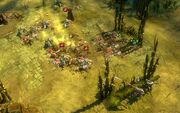
The Slugga Boy squads are suppressed and have already taken heavy casualties because of not retreating
In Dawn of War II, certain weapons cause "courage damage" that reduces a regenerating courage resource of a unit. When a unit's courage reaches 0, it becomes "suppressed". Suppressed units become dramatically slowed and practically unable to attack until their courage regenerates. If they are still affected by the suppressing weapon, this will obviously not happen.
Suppression can be broken by certain abilities such as Frenzy or Combat Stimulants or by using the Fall Back command. If the unit can avoid the attack (or the attack is interrupted), courage will regenerate in a short while and the unit can act normally again.
Vehicles and special hero/infantry units (e.g., the Hive Tyrant and Terminators) cannot be suppressed.
Knockback
Some weapons and abilities cause knockback, which knocks infantry units to the ground, unable to move or attack until the unit gets back up. Typical sources of knockback are charge abilities, melee special attacks, and explosives (such as artillery weapons and grenades).
There are two types of knockback in the game; one is called "weapon knockback" and the other "ability knockback" in the data files. The distinction is quite important for a successful multiplayer career.
- Weapon knockback is the "regular" type of knockback, caused by melee special attacks, grenades, most knockback abilities, and such. This type of knockback does not affect retreating units or extremely heavy infantry (e.g. Terminators or the Hive Tyrant).
- Ability knockback is a special effect which also affects retreating units and Terminators. It is caused by charge attacks, global nukes, walker vehicle special attacks, Devastator plasma cannons and some abilities. Ability knockback can be used to stop and wipe out retreating units.
Infiltration and detection
Certain units have the ability to "infiltrate", becoming invisible to the enemy. If they attack or use abilities, they will become partially revealed (flashing red), and can be attacked but take -20% reduced damage. If they stop attacking they will become infiltrated again.
Infiltrated units will be fully revealed if they wander very close to enemy units – the "keen sense" radius being 5 for most units – but certain infantry units can detect infiltrated enemies in a radius of 30–40 (almost full sight radius). These units are called "detectors" and marked with the eye ![]() decorator icon. In some cases (e.g., Scouts and Rangers) the same unit can both infiltrate and detect. Detectors, by race:
decorator icon. In some cases (e.g., Scouts and Rangers) the same unit can both infiltrate and detect. Detectors, by race:
- Space Marines: Scout Squad with the Scout Sergeant (radius 30)
- Eldar: Rangers (radius 40); Farsight (radius 35)
- Orks: Shoota Boyz with the Nob Leader; Kommando Squad (both radius 30)
- Imperial Guard: Sentinel (radius 15); Catachan Devils (radius 30); Holy Pyre (radius 20)
- Chaos: Chaos Heretics with the Aspiring Champion (radius 30)
- Tyranids: Warrior Brood; Venom Brood; Lictor (all radius 30)
Armor types
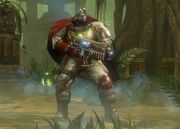
Scout (infantry)
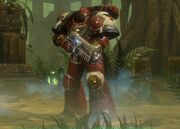
Tactical Marine (heavy_infantry)
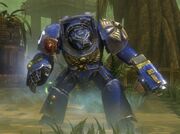
Terminator (super_heavy_infantry)
Units in the Dawn of War II series possess one of several available armor types. This determines how vulnerable or resistant they are to different types of damage (see "damage types and weapon families" below).
The armor types according to latest data (Retribution) are:
- commander (heroes): Some resistance against light ranged fire and light melee weapons
- infantry (e.g. Scouts, Guardians): Light infantry; suffer 100% of most damage but less from plasma weapons
- infantry_fire_resist (e.g. Heretics, Gaunts): Like infantry, but suffer reduced flame damage
- heavy_infantry (e.g. Tactical Marines, Wraithguard): Resistant to small arms fire, but more vulnerable to plasma, power weapons and grenades
- super_heavy_infantry (e.g. Terminators, Avatar): Even more resistant to small arms, suffer additional damage from power weapons
- vehicle (e.g. Razorback, Carnifex): Almost impervious to small-arms fire, only vulnerable to anti-vehicle weaponry
- building (HQ buildings): Resistant to most damage types, can be damaged by ranged anti-vehicle weapons
- building_defense (turrets): Resistant to small arms, vulnerable to anti-vehicle weapons, very vulnerable to flame damage
- building_light (generators): Somewhat resistant to small arms, vulnerable to anti-vehicle, very vulnerable to flamers
The above is a very rough outline of the major advantages and drawbacks of each armor type. For details, consult the data tables of relevant units, weapons and damage types. Note that weapon efficiency against a target is also affected by the weapon family and the unit's size, which determine accuracy.
Damage types and weapon families
...
Melee resistance
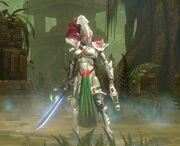
Howling Banshees receive reduced melee damage
Certain units – generally heroes and close-combat squads – have a "melee resistance aura" that causes the unit to receive reduced (-40%) melee damage. This is important to know in order to predict how a fight involving these units will turn out. Generally these units have high melee damage, and with the melee damage resistance, it is often better to avoid close combat and shoot them down instead – they still take full ranged damage.
A notable exception to melee resistance being limited to melee specialists are Tactical Marines and Chaos Space Marines , who have the aura in spite of being a primarily ranged unit.
Experience
Most units gain experience points through through killing enemy units and reviving allied commanders. Experience points grant veterancy levels, which award bonuses such as improved health and damage. Some specific abilities such as Tyranid synapse auras and the Apothecary's healing abilities improve with veterancy levels. Regular units have 4 levels, while heroes have 10.
Each model in the game has a designated XP value. When the model is killed, this XP value is spread out to all units that did damage to it. In addition, units that gain experience share it to all friendly units within a 55 radius (the sight radius for most units is 40). These units gain 40% of the XP that the original unit gained.
Every unit requires 500 XP per level. Leveling up grants various general bonuses listed below (values are rounded approximations and in comparison to base stats).
- Level 1 (0 XP): Base stats
- Level 2 (500 XP): +15% health and energy, +5% regeneration, +1 melee skill, +10% melee damage, +5% ranged damage
- Level 3 (1,000 XP): +30% health and energy, +10% regeneration, +2 melee skill, +20% melee damage, +10% ranged damage
- Level 4 (1,500 XP): +50% health and energy, +15% regeneration, +3 melee skill, +30% melee damage, +15% ranged damage
Heroes gain 50% more XP than other units and continue progressing up to level 10. Reviving allied heroes grants the reviver 250 XP.




